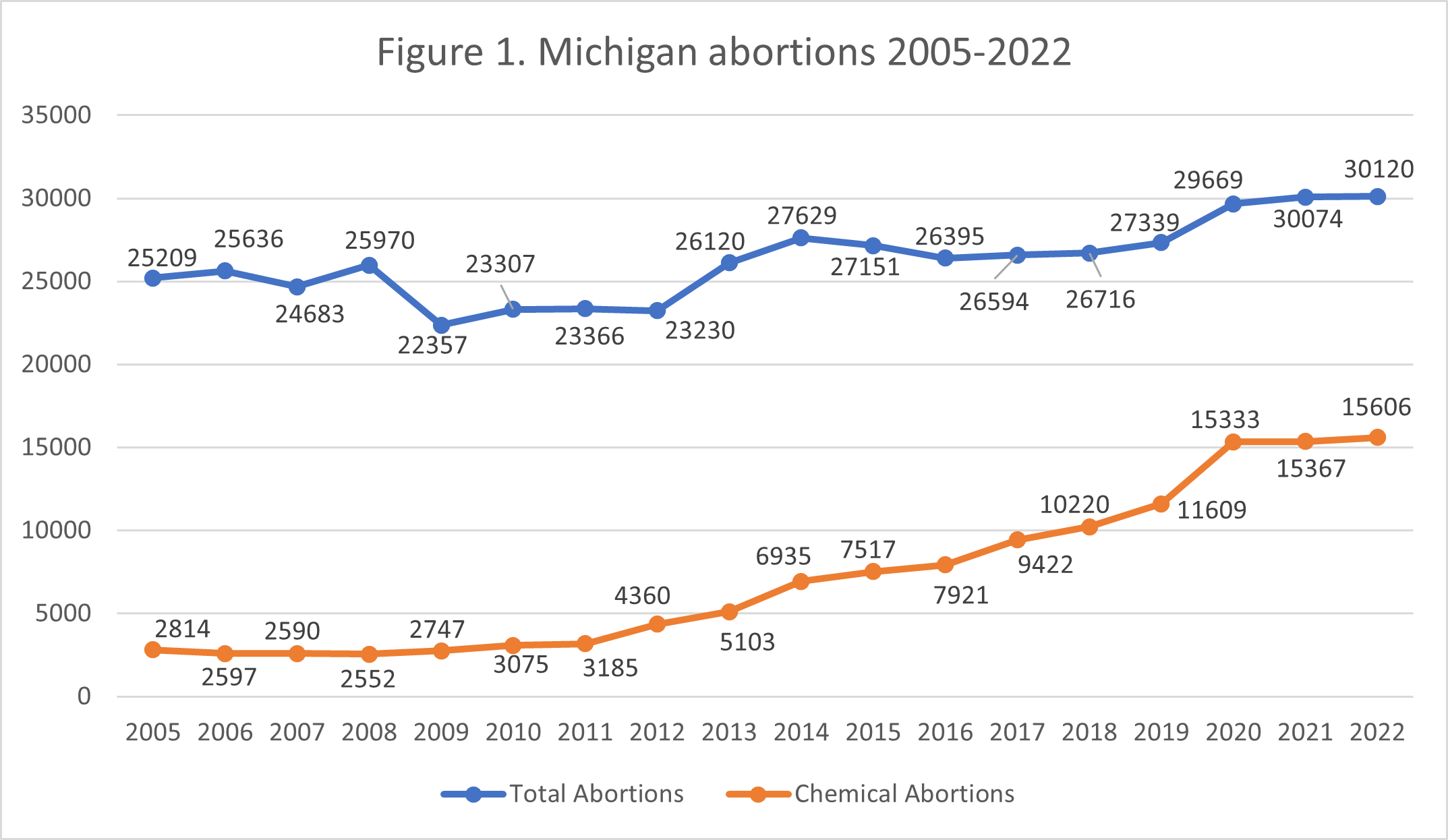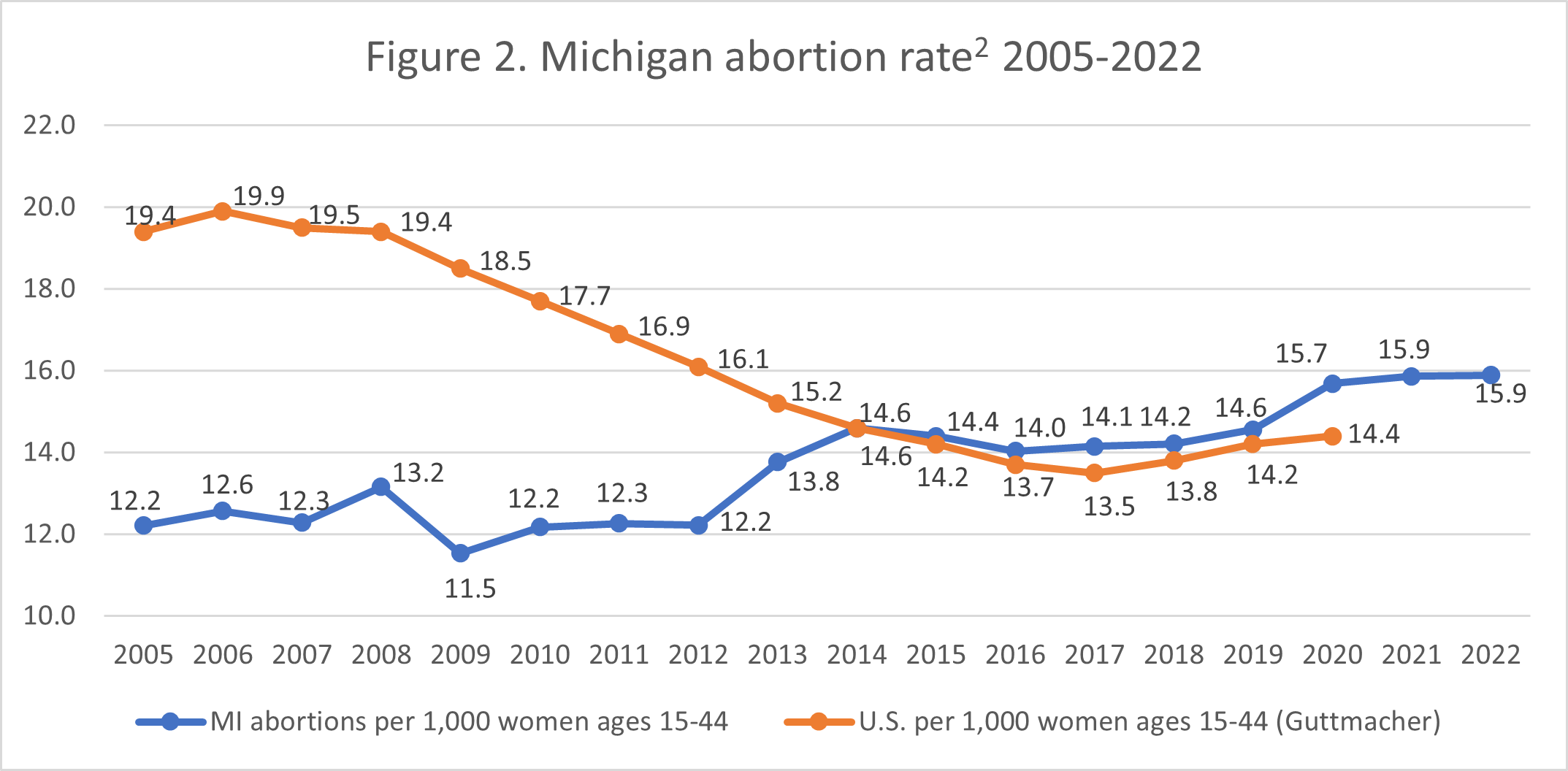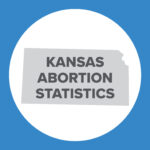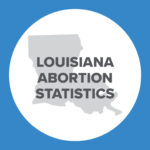Abortion Reporting: Michigan (2022)
Michigan’s Department of Health and Human Services published its 2022 abortion statistics in June 2022, showing that abortions had increased from the previous year.
Statistics and Changes in Michigan Abortions, 2021-2022

The report does not include information on Planned Parenthood’s Michigan abortion market share.
Abortion Totals and Trends
In 2022, there were 30,120 abortions reported in Michigan, up less than one percent (0.2 percent) from the previous year and the highest reported total since 1996. Chemical abortions increased slightly as well (by two percent), constituting 52 percent of the total in 2022 (Fig. 1). The Charlotte Lozier Institute (CLI) estimates that Michigan’s 2022 abortion rate remained the same as its rate in 2021: 15.9 abortions per 1,000 women ages 15 to 44 (Fig. 2). As of July 2023, 12 states have released 2022 statistics, nine of which showed that abortions increased from 2021.
State Report Summary
Resident Abortions
In 2022, 91 percent of Michigan abortions were performed on residents, and much of the information in Michigan’s report is only for abortions performed on Michigan residents, with abortions on nonresident women excluded. Eight percent of the abortions performed on Michigan residents were on girls younger than 20, and 27 percent were on women ages 20 to 24. Twenty-nine percent were on women ages 25 to 29, while 23 percent were on women ages 30 to 34 and 10 percent on women ages 35 to 39. Three percent of the abortions were on Michigan residents ages 40 and older. Just under one percent of abortions were on women whose age was not reported.
Over half of Michigan resident abortions were performed on black women (54 percent), while 36 percent were obtained by white women. Two percent were performed on Asian or Pacific Islander women, 0.6 percent on American Indian women, two percent on women of other races, and two percent on women of multiple races. Three percent of the abortions were on women whose race was not reported. The black abortion rate (49.2 abortions per 1,000 women ages 15 to 44) was over seven times the white abortion rate of 6.9. Michigan reports ethnicity separately from race, and four percent of resident abortions were performed on Hispanic women.
Eleven percent of resident abortions were on married women, 85 percent on unmarried women, and three percent on women of unknown marital status. Just under half of the abortions (49 percent) were on women who had reported no previous abortions, just under a quarter (24 percent) were on women with one prior abortion, and just over a quarter (26 percent) were on women with more than one. Just under a quarter of the abortions (24 percent) were performed on women who previously had a miscarriage. Thirty-six percent of Michigan resident abortions were performed on women with no previous term pregnancies, which Michigan defines as a pregnancy “which lasted 37 weeks or longer, regardless of the outcome.” A quarter of the abortions were obtained by women with one prior term pregnancy, and 40 percent were on women with more than one.
Michigan records the entity that referred each woman to the abortion facility, and in 2022, a majority of the abortions (89 percent) were self-referrals. Ten percent of the women undergoing abortions were referred by friends or family members, and only one percent were referred by a physician. Twenty-six women were referred by a family planning agency, five women by the state’s health department, three by a social agency, and two by clergy. There were 23 women who received some other referral, and the source of referral was not reported for 42 abortions. The vast majority of the abortions on Michigan residents, 97 percent, were self-paid, while a little over two percent were covered by insurance.
Total Abortions
Sixty-six percent of all abortions reported in Michigan occurred at eight weeks of gestation or earlier, with one percent performed before five weeks of gestation and 65 percent performed between five and eight weeks. Twenty-one percent were performed between nine and 12 weeks. Eight percent of the abortions occurred from 13 to 16 weeks of gestation and three percent were performed between 17 and 20 weeks. There were 406 abortions, one percent of the total, performed at 21 weeks and later; of these, 401 abortions were performed between 21 and 24 weeks and five between 25 and 28 weeks. Zero abortions were reported after 28 weeks. Gestational age was not reported for 93 abortions.
A majority of the abortions reported in Michigan, 52 percent, were by chemical means. Forty-one percent were suction curettage procedures, and seven percent were dilation and evacuation (dismemberment) abortions. There were three abortions performed using saline or prostaglandins and three performed via hysterectomies/hysterotomies. Twenty-two abortions were performed using other, unspecified methods, and the type of procedure was not reported for 67 abortions.
In 92 percent of cases, pregnancy was confirmed via ultrasound. For eight percent, pregnancy was confirmed with a home urine test, and for 0.4 percent, pregnancy was determined with a lab urine test. There were nine pregnancies confirmed using a lab blood test, four in which another method was used, and seven that were not tested. There were 24 abortions for which an unknown method was used to confirm pregnancy.
Eighty-six percent of Michigan abortions were performed in freestanding abortion facilities. Only 0.1 percent were performed in doctor’s offices, 0.6 percent in hospitals, and 13 percent were performed in some other type of facility. Six percent (1,702) of the unborn babies killed by abortion weighed one to 99 grams, and three percent weighed between 100 and 399 grams. There were 214 babies who weighed 400 grams or more (0.7 percent). However, weight was not determinable for 91 percent of the unborn babies.
Of note are the five counties with the highest Michigan-resident abortion rates. Wayne County (which includes Detroit City) had an abortion rate of 30.2, with 10,641 abortions total performed on county residents. Detroit itself had an abortion rate of 49.4 (almost three and half times the national rate as estimated by the Guttmacher Institute in 2020), and the rest of Wayne County, excluding Detroit, had an abortion rate of 18.8. Detroit’s abortion total constituted just under one quarter (24 percent) of the state’s total abortions. Other counties with high abortion rates include Oakland County (15.1, 3,546 abortions), Macomb County (18.4, 3,005 abortions), Genesee County (20.5, 1,538 abortions), and Kent County (10.6, 1,463 abortions).
Abortion Complications
There were four immediate complications reported during 2022 Michigan abortion procedures, including one instance of cervical laceration and three instances of hemorrhage.1 One complication each occurred within gestational time periods nine to 12 weeks, 13 to 16 weeks, 17 to 20 weeks, and 21 to 24 weeks. Three of the four complications occurred during suction curettage procedures and one occurred during a dilation and evacuation procedure. Three of the immediate complications occurred during an abortion performed at a hospital and one during an abortion at a freestanding outpatient surgical facility.
Additionally, 178 abortions resulted in complications that were reported subsequent to the abortion procedure, an increase of 35 percent from 2021. Multiple complications can be reported for each abortion. There were 115 failed abortions, an increase of 32 percent from 2021 (“failed abortion” usually indicates that the abortion did not work, and the pregnancy is ongoing). There were 43 cases of retained products, 10 instances of hemorrhage, eight infections, two cases each of shock and uterine perforation, one instance of cervical laceration and three other, unspecified complications.
Six of the subsequent complications were suffered by women under the age of 20, 48 by women between the ages of 20-24, 67 by women aged 25-29, 38 by women aged 30-34, 16 by women aged 35-39 and two by women who were 40 or older. Three subsequent complications occurred after pregnancies at five weeks gestation or less were terminated, 93 after abortions at five to eight weeks gestation, 52 after abortions at nine to 12 weeks gestation, 10 after 13 to 16 weeks gestation, three after abortions at 17 to 20 weeks gestation, and two after abortions at 21 weeks gestation or later. Seventy-five of the subsequent complications were associated with suction curettage abortions, 89 with chemical abortions, 10 with dilation and evacuation abortions, two with hysterectomies/hysterotomies, and two with other, unspecified methods.
Legislative Changes
In May 2022, before Roe v. Wade was overturned, the Michigan Court of Claims placed a preliminary injunction on a 1931 law that prohibited abortion at conception except in the case where the mother’s life was endangered. Consequently, the law never went into effect when Roe was overturned on June 24, 2022, and the law in Michigan remained unchanged: abortion was legal at virtually any point in the pregnancy, as the state’s viability law (HB 5542) contained a health exception so broad that it could be used to justify any abortion, no matter how far along the mother’s pregnancy.
On September 7, 2022 a Michigan court declared that the 1931 law was unconstitutional and unenforceable. Further, in the state’s November 2022 election, a ballot measure (Proposal 3) that established a state constitutional right to “reproductive freedom,” including abortion, passed with a vote of 56.7 percent to 43.3 percent. The ballot measure was added to the state constitution and notes that the state may continue to regulate abortion after fetal viability except if abortion “is medically indicated to protect the life, physical health, or mental health of the pregnant individual.” Following Proposal 3’s passage, the 1931 law was overturned on December 24, 2022 when the ballot measure took effect. In April 2023, Michigan Governor Gretchen Whitmer signed HB 4006/SB 2, fully removing the 1931 law from Michigan’s statute code. This legislation goes into effect 91 days after the adjournment of Michigan’s 2023 legislative regular session (December 31, 2023), meaning the law will not go into effect until March 31, 2024.
State Ranking
In 2016, CLI published a paper surveying abortion reporting across the country, and Michigan’s reporting tied for seventh best. CLI has previously recommended that Michigan could make its reporting even better by providing information for all abortions occurring in the state, not just those performed on residents. Additionally, Michigan could identify the states from which nonresident women travel for abortions, particularly as the state positions itself to become a destination for out-of-state women seeking abortion.


- Statistics on abortion complications reported here represent a minimal number of deaths and complications, as this data is collected in a non-systematic and non-verifiable way. As such, this data cannot be used to calculate either an accurate abortion mortality rate or an accurate abortion complication rate for the state.
- National rates were calculated by Guttmacher Institute. Michigan rates were calculated by CLI using the following formula: (total number of abortions performed in Michigan ÷ number of resident women ages 15-44) x 1,000. Rates may differ slightly from previous CLI articles due to revised population estimates. Population estimates were obtained from the CDC WONDER database. Estimates for 2005-2009 are intercensal estimates of the July 1 resident population. Estimates for 2010-2019 are Vintage 2020 postcensal estimates of the July 1 resident population. Estimates for 2020-2022 are Vintage 2021 postcensal estimates of the July 1 resident population as the CDC has not released 2022 population estimates yet. Estimates were produced by the U.S. Census Bureau and the National Center for Health Statistics.



























